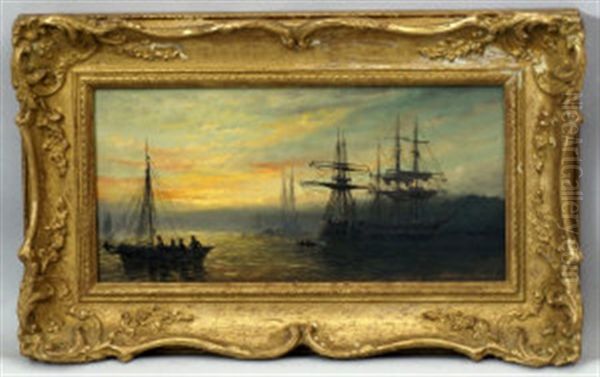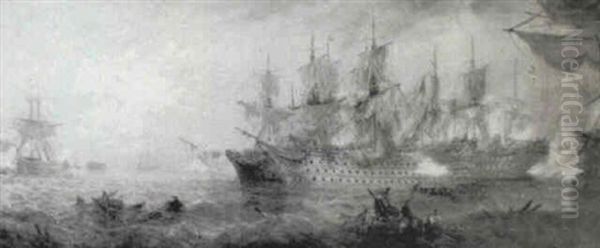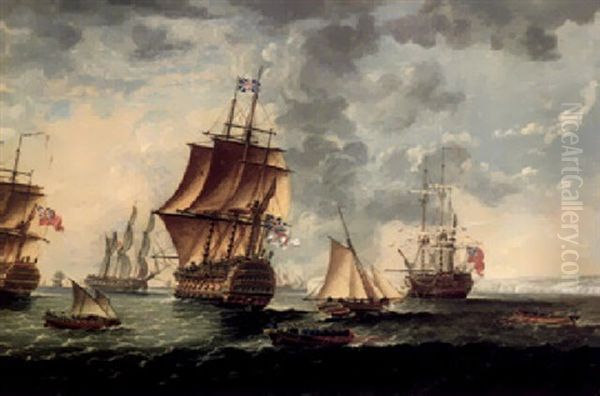William Adolphus Knell stands as a significant figure in the rich tradition of British marine painting during the 19th century. Active throughout much of Queen Victoria's reign, Knell dedicated his artistic career to capturing the diverse moods of the sea and the intricate details of the vessels that sailed upon it. His work, appreciated in his own time and increasingly valued today, offers a fascinating window into the maritime world of Victorian Britain.
Origins and Early Career
Born in London in 1801, William Adolphus Knell entered the world during a period of intense maritime activity and national focus on naval power for Great Britain. While specific details about his formal artistic training remain scarce, suggesting he may have been largely self-taught or learned through less formal means, his early work clearly shows an awareness and assimilation of established artistic traditions. It is known that, like some other artists of the period, he may have initially engaged in decorative work, possibly related to furniture, before fully dedicating himself to marine painting.
His emergence as a professional artist coincided with a burgeoning public interest in seascapes and naval subjects. Britain's identity was inextricably linked to the sea, through trade, exploration, and naval dominance. Knell tapped into this national consciousness, finding a ready audience for his depictions of coastal life, shipping traffic, and the ever-changing character of the British coastline and its surrounding waters.
Artistic Style and Development
Knell's early artistic style demonstrates a clear affinity with the Dutch Golden Age marine painters of the 17th century. This influence is visible in the meticulous attention to detail, the careful rendering of ships' rigging and hulls, and often, a relatively calm and ordered composition. He displayed a remarkable ability to capture the textures of wood, canvas, and water, lending a tangible reality to his scenes.

However, as his career progressed, Knell's style evolved. While retaining a commitment to accuracy and detail, particularly in the depiction of vessels, his work began to embrace elements more characteristic of the developing British school of marine painting. This shift involved a greater emphasis on atmospheric effects – the play of light on water, the drama of changing weather conditions, and the rendering of mist, haze, or storm clouds. Some later works exhibit a slightly broader handling of paint, though he never fully abandoned the precision that marked his earlier output. This transition reflected broader trends in British art, moving towards a more romantic and atmospheric interpretation of nature, famously championed by artists like J.M.W. Turner.
Knell primarily worked in oils, producing canvases that ranged in size. While many of his popular works were of moderate dimensions, suitable for domestic display, he was also capable of executing larger, more imposing compositions. His technical skill allowed him to convincingly portray the subtle nuances of calm, reflective waters as well as the dynamic energy of rough seas and stormy skies.
Subjects and Themes
The core of William Adolphus Knell's oeuvre revolves around the sea and shipping. He painted a wide variety of vessels, including majestic naval warships, bustling merchantmen, humble fishing boats, and coastal craft. His settings were equally diverse, ranging from busy ports and estuaries, such as the Thames, to open sea vistas and specific coastal locations around Britain, like Margate or the Foreland.
He was adept at capturing maritime life in its various forms. Scenes often depict ships navigating channels, anchored in harbours, battling the elements, or engaged in everyday activities like fishing. The interaction between the vessels and their environment – the state of the tide, the time of day, the prevailing weather – was a key element of his compositions. He excelled at depicting light, whether the soft glow of dawn, the bright clarity of midday, or the dramatic hues of sunset.
Beyond general shipping scenes, Knell also documented specific historical events and vessels. His work provides valuable visual records of naval engagements, ship portraits, and significant maritime occasions, linking his art directly to the historical narrative of his time.
Notable Works
Several paintings stand out as representative of Knell's skill and thematic interests.
HMS 'Nemesis' attacking Houchung Fort in the Canton River: This work, depicting an event from the First Opium War in 1841, showcases Knell's ability to handle historical subjects and naval action. The painting captures the drama and intensity of the engagement, detailing the steam-powered warship 'Nemesis' and the surrounding Chinese junks amidst the smoke of battle. It reflects the British public's interest in events unfolding in the expanding empire.

The East Indiaman Exeter making for the Ladrone Islands, China, 1805: This painting looks back to an earlier era, depicting a specific vessel associated with the powerful East India Company. It highlights Knell's skill in ship portraiture, accurately rendering the 'Exeter' under sail, and evokes the long and often perilous voyages undertaken in the pursuit of trade with the East.
Shipping at Dawn and Fishing in the Net at Dusk: Titles like these represent a common theme in Knell's work – the depiction of maritime activity at different times of day. These paintings often focus on the atmospheric effects of light, capturing the tranquil beauty or quiet industry of coastal life during the transitional hours of sunrise and sunset. His ability to render the subtle gradations of light on the water and in the sky was highly refined.
Off Margate & Off the Foreland and Shipping off the Coast: These titles indicate Knell's frequent depiction of specific locations along the British coast, particularly the busy shipping lanes of the English Channel and Thames Estuary. These works often feature a variety of vessels navigating familiar waters, appealing to contemporary viewers familiar with these coastal landmarks.
The Landing of Prince Albert: This work is significant as it represents a prestigious commission. Knell received at least two commissions from Queen Victoria, and this painting, likely depicting the Prince Consort's arrival for a specific occasion, underscores the artist's standing and recognition at the highest levels of society. Such works required not only accurate depiction but also a sense of occasion and decorum.
Exhibitions and Recognition
William Adolphus Knell was a consistent and successful exhibitor throughout his career. He regularly submitted works to the prestigious annual exhibitions at the Royal Academy of Arts in London, showing there frequently between 1825 and 1866. He also exhibited extensively at the British Institution, another major London venue, from 1825 to 1867. His presence in these key exhibitions ensured his work was seen by critics, collectors, and the art-loving public, cementing his reputation.

His success was not limited to exhibitions. As mentioned, he received patronage from Queen Victoria herself, a significant mark of favour. Furthermore, he engaged in collaborations, such as working with the well-known publishing house Ackermann & Company, likely involving the creation of images for reproduction as prints, particularly historical or topographical aquatints. This would have broadened the reach of his imagery beyond original paintings. The quality and sheer volume of his output led to his works being acquired by numerous private collectors and, eventually, public institutions.
Contemporaries and Context
William Adolphus Knell worked during a vibrant period for British marine painting. He was contemporary with several other notable artists specializing in or frequently depicting maritime subjects. Understanding his work in relation to these artists helps situate his contribution.
Among his contemporaries were:
J.M.W. Turner (1775-1851): While Turner's later work became highly abstract and focused on light and energy, his earlier marine paintings set a high bar for dramatic and atmospheric seascapes.
Clarkson Stanfield (1793-1867): A highly successful and respected marine and landscape painter, known for his dramatic compositions and accurate depiction of ships and coastal scenery. Stanfield was a friend of Charles Dickens and a prominent figure in the art world.
Edward William Cooke (1811-1880): Known for his meticulous and detailed paintings of shipping and coastal views, often with a scientific interest in natural forms and maritime technology.
George Chambers Sr. (1803-1840): A talented marine painter whose career was cut short, known for his fresh and vigorous depictions of naval scenes and coastal life.
John Wilson Carmichael (1800-1868): A prolific marine artist, particularly associated with the North East coast of England, known for his detailed shipping scenes and historical naval subjects.
Thomas Luny (1759-1837): An older contemporary whose career overlapped with Knell's early years, known for his prolific output of coastal scenes and ship portraits, often depicting Devon coastal life.
Alfred Gomersal Vickers (1810-1837): Another artist whose promising career was brief, known for coastal and river scenes.
David Roberts (1796-1864): Primarily famous for his topographical views of the Near East and Europe, Roberts also painted some notable coastal and harbour scenes.
James Casement and Charles R. A. Casement: Less widely known today, but active marine painters during the period.
Thomas Thornley (fl. 1858-1898): A later marine painter whose works sometimes appear alongside Knell's in collections or auctions, indicating stylistic similarities or shared market appeal.
Myles Birket Foster (1825-1899): Primarily a watercolourist known for idyllic rural landscapes, Foster often included coastal elements and boats in his popular works.

Within this context, Knell carved out a niche for himself through his consistent quality, detailed rendering (especially of ships), and his ability to capture both tranquil and dramatic aspects of the sea. He may not have reached the revolutionary heights of Turner or the widespread fame of Stanfield, but he was a highly competent, respected, and prolific contributor to the genre.
The Knell Legacy: Father and Son
A significant aspect of William Adolphus Knell's legacy is intertwined with his family. He was the father of William Callcott Knell (c. 1830-1880), who followed in his father's footsteps to become a successful marine painter in his own right. William Callcott Knell exhibited at major venues like the Royal Academy and the Society of British Artists. While his style was naturally influenced by his father, he developed his own variations within the marine genre. The existence of two prominent marine painters named Knell, father and son, active in the same century, sometimes leads to confusion but also highlights a familial dedication to the subject. This "Knell dynasty" contributed significantly to the body of Victorian marine art.
Later Appreciation and Conclusion
While highly regarded during his lifetime, William Adolphus Knell's reputation, like that of many Victorian artists, may have experienced fluctuations in the 20th century as artistic tastes changed. However, in more recent decades, there has been a renewed appreciation for the skill and historical value of Victorian marine painting. Knell's works are sought after by collectors and appear regularly at auction, often commanding respectable prices that reflect their quality and historical interest. His paintings are held in various public collections, including the National Maritime Museum in Greenwich, ensuring their preservation and accessibility for future generations.
William Adolphus Knell died in 1875, leaving behind a substantial body of work that captures the essence of Britain's relationship with the sea during a transformative century. His paintings are more than just depictions of ships and water; they are documents of maritime technology, coastal life, historical events, and the enduring power and beauty of the marine environment. Through his detailed observation, technical proficiency, and evolving style, Knell secured his place as a master of the Victorian seas, an artist whose work continues to engage and inform viewers today. His dedication to the marine genre, coupled with the continuation of this tradition by his son, marks a notable contribution to the history of British art.